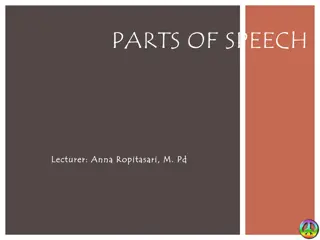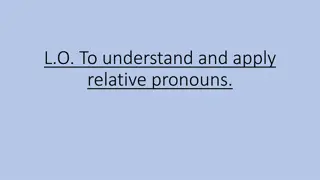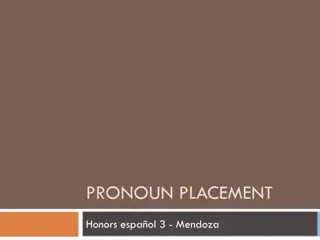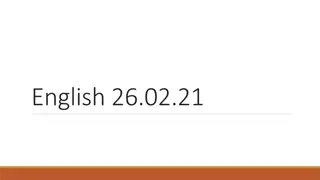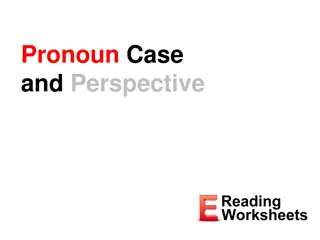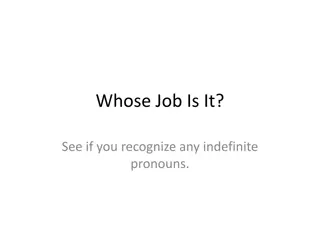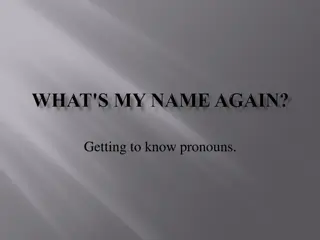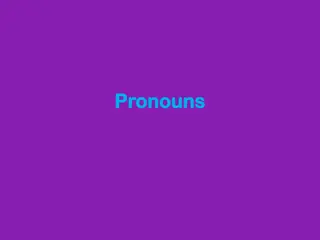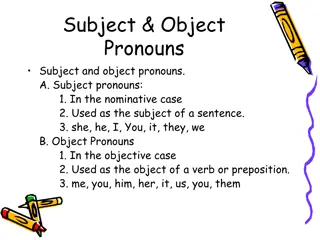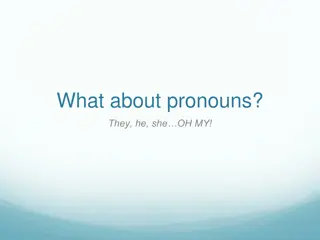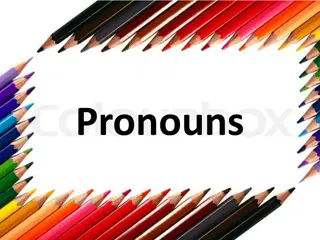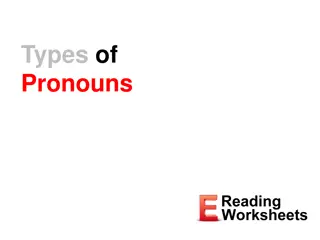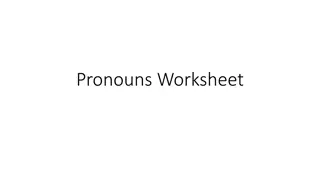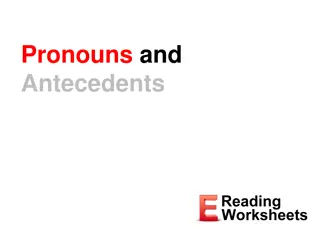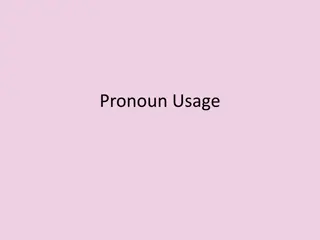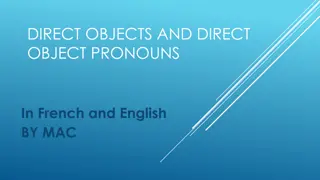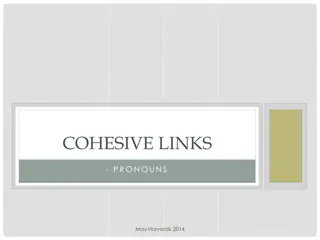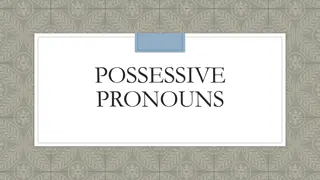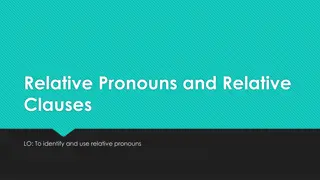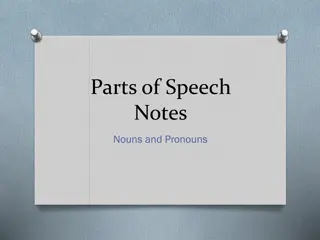Understanding Pronouns: Types and Usage
Pronouns are vital elements in language that replace nouns to avoid repetition and make sentences concise. They include personal, possessive, reflexive, intensive, indefinite, demonstrative, relative, interrogative, and reciprocal pronouns. Personal pronouns serve as subjects (e.g., I, he, she) or objects (e.g., me, him), while possessive pronouns indicate ownership (e.g., mine, yours). Reflexive pronouns refer back to the subject, and intensive pronouns emphasize the subject. Knowing the different types of pronouns is essential for effective communication.
Download Presentation

Please find below an Image/Link to download the presentation.
The content on the website is provided AS IS for your information and personal use only. It may not be sold, licensed, or shared on other websites without obtaining consent from the author. Download presentation by click this link. If you encounter any issues during the download, it is possible that the publisher has removed the file from their server.
E N D
Presentation Transcript
PRONOUN PRONOUN Presented by: SHUVASISH SIR
Pronoun A Pronoun is a word that is used instead of a noun- equivalent. It is the replacement of noun. Pronoun Noun Noun Noun Common pronouns are I, me, he, she, him, his, her, they, them, it, we, us, etc. Example: - She is a pretty girl. - His contribution is appreciable. - They are unbeatable. - This job is done by them.
Role of Pronoun in a Sentence: Pronouns are usually short words and they are used to make sentences less cluttered and less repetitive.
Kinds of Pronoun: There are many different kinds of pronouns; such as: 1. Personal Pronoun 2. Possessive Pronoun 3. Reflexive Pronoun 4. Intensive Pronoun 5. Indefinite Pronoun 6. Demonstrative Pronoun 7. Relative Pronoun 8. Interrogative Pronoun 9. Reciprocal Pronoun.
i. Personal Pronoun: A personal pronoun is used instead of a person. Such as I, you, he, she, we, they and who. When a personal pronoun is the subject of a verb, it is called Subjective Pronoun (I, we, he, she, they, and you). E.g. I love this book. When a personal pronoun is not a subject and acts as the object, then it is called Objective Pronoun (me, you, her, him, it, us, them and whom). E.g. Give it to him.
ii. Possessive Pronoun: A Possessive Pronoun shows ownership of something. Such as his, hers, its, mine, yours, ours, and theirs. Example: - This pen is mine. - Yours one is not real. - Take hers from the room.
iii. Reflexive Pronoun: Reflexive Pronoun refers back to the subject in the sentence. They are myself, himself, herself, ourselves, themselves, yourselves and itself. Example: - I ask myself when I take a decision. - He spoke to himself. - We learn about ourselves everyday.
iv. Intensive\ Empathetic Pronoun: An Intensive Pronoun is used for emphasis. Intensive pronouns are myself, himself, herself, yourself, itself, yourselves, ourselves and themselves. Example: - I myself have done the job. - The president himself visited the area. - He himself can t do it.
v. Indefinite Pronoun: An Indefinite Pronoun refers to an indefinite or non-specific person or thing. Indefinite pronouns are any, anything, some, someone, somebody, everybody, everything, everyone, nobody, none, one, several, some, few, many and each.
An Indefinite pronoun may look like an indefinite adjective, but it is used differently in sentences by taking the place of a noun. Example: - All people gathered here for the same purpose. - Does anyone know anything about the matter? - Anybody can play the game easily. - None but the brave deserves the fair. - Each must do his best. - One must do one s duty.
vi. Demonstrative Pronoun: A Demonstrative Pronoun particularly point out a noun. This, these, that and those are demonstrative pronouns to point out a noun. A Demonstrative pronoun stands alone but a demonstrative adjective qualifies a noun. Example: - You can smell that from here. - This smells good. - Those were bad days. - Look at that. - Would you deliver this?
vii. Relative Pronoun: A Relative Pronoun is a pronoun that introduces or links one phrase or clause to another in the sentence. Relative Pronoun are that, who, whom, where, when, whoever, whichever and whomever. Example: - The person who called me is my uncle. - I know where I am going. - The pen which I lost was red.
- You should buy the book that you need for the course. - Robii Thakur is a poet who wrote the National Anthem. Who and whom refer only to people. Which refers to things, qualities and ideas. That and whose refer to people, qualities, things and ideas.
viii. Interrogative Pronoun: An Interrogative Pronoun is used to ask question. It helps to ask about something. Interrogative Pronouns are who, which, what, whom, whose; as well as whoever, whomever, whichever and whatever. It is used in the beginning of the sentence. Who and whom refer to person. What refers to thing. Which refers to person or thing and whose refers to person as possessive.
Example: - What s happened? - What do you expect from me? - Who designed this website? - Whose mobile is this? - Whatever did you want?
ix. Reciprocal Pronoun refers the relations between two or more persons or things. Each other and one another are Reciprocal Pronouns. We use Reciprocal Pronouns when there are two or more persons or things doing the same thing. Example: - Rimi and Raju like each other. - Why don t we believe each other? - They do not tolerate each other. - We should help one another.
THANK YOU!! LINGUA FRANCA



